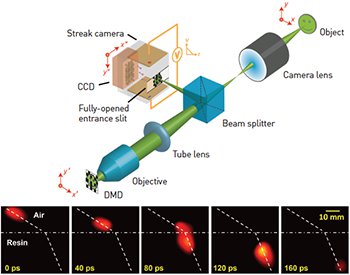 (Top) CUP system configuration. DMD, digital micromirror device. (Bottom) Real-time visualization of a laser pulse refracted at an air-resin interface.
(Top) CUP system configuration. DMD, digital micromirror device. (Bottom) Real-time visualization of a laser pulse refracted at an air-resin interface.
Direct visualization of transient events holds great interest in physics, chemistry and biology. Existing CCD or CMOS detectors have limited on-chip storage and data readout speeds, however, and so cannot image events lasting less than 1 ns.1 The streak camera—an ultrafast imager that converts time to space by pulling photoelectrons with a sweeping voltage along the axis perpendicular to the device’s entrance slit—breaks that speed limit. Yet the streak camera conventionally is a 1-D imager, acquiring one line of the scene per measurement. That makes mechanical scanning necessary to obtain a 2-D image, so the transient event must be reproducible for repetitive measurements.2
Last December, we reported a new computational ultrafast imaging method, compressed ultrafast photography (CUP), that can capture a non-repetitive 2-D transient event at up to 100 billion frames per second in a single-shot measurement.3 As with a typical digital camera, CUP does not need specialized active illumination. This receive-only characteristic allows the technique to be used for high-speed video recording of a variety of luminescent (for example, fluorescent or bioluminescent) objects.
CUP operates in two steps. First, the dynamic scene is imaged to a digital micromirror device (DMD) that spatially encodes it. Each micromirror is turned “on” or “off” to display a random binary pattern. The light reflected from the “on” micromirrors passes to the fully opened entrance slit of a streak camera, inside of which the encoded image is temporally sheared and compressively recorded in a single image. A random binary pattern tags the spatiotemporal information and acts as the key to unlock and retrieve the image in the subsequent computational image reconstruction. Given sparsity in a typical input scene, the original event data cube can be estimated by employing a compressed-sensing reconstruction algorithm.4
CUP has been used for real-time visualization of various light-speed phenomena.3 In one example, we recorded a single laser pulse refracted at an air-resin interface. CUP has also imaged light reflection, photon racing in two different media, and apparent faster-thanlight propagation. To expand the technique’s functionality, we added a color separation unit to the system, which enabled acquisition of multi-wavelength transient 2-D events within a single camera snapshot. As a generic imaging platform in both fundamental and applied sciences, CUP holds great promise in studying various non-repetitive complex transient events.
Researchers
Jinyang Liang, Liang Gao, Chiye Li and Lihong V. Wang, Washington University in St. Louis, St. Louis, Mo., USA
References
1. M. El-Desouki et al. Sensors 9, 430 (2009).
2. A. Velten et al. Nat. Commun. 3, 745 (2012).
3. L. Gao et al. Nature 516, 74 (2014).
4. J.M. Bioucas-Dias et al. IEEE Trans. Image Process. 16, 2992 (2007).
